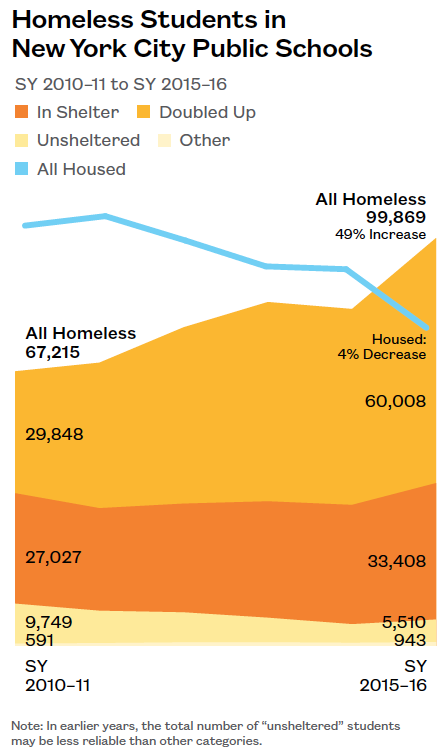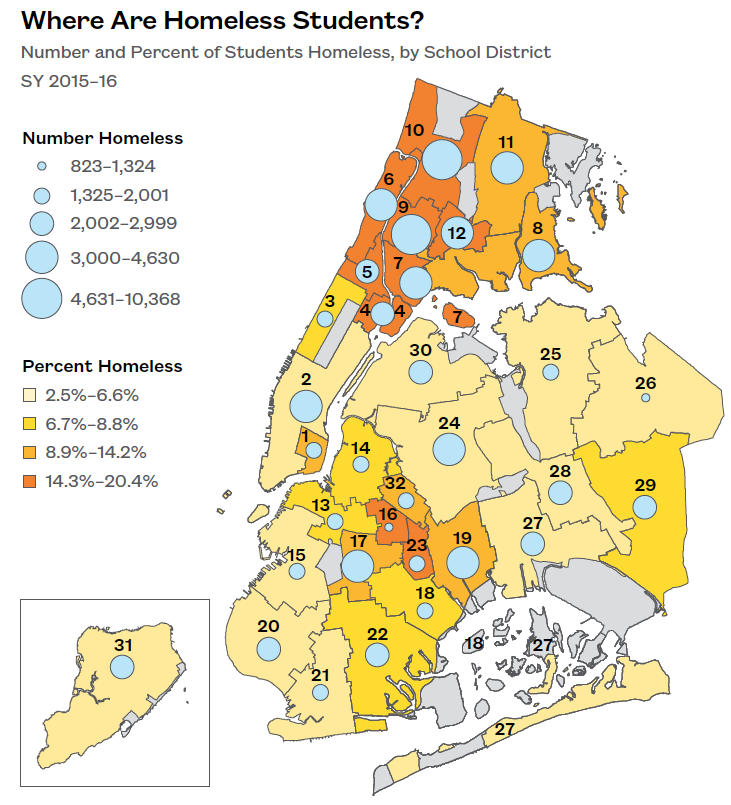With the launch of the 2017 On the Map: The Atlas of Student Homelessness in New York City, we see that student homelessness is rapidly growing in New York City public schools. Over the last six years, the number of homeless students overall increased nearly 50%, while the number of housed students has actually decreased. In fact, every single school district saw an increase in student homelessness between SY 2014-15 and SY 2015-16. No matter where you live in New York City, there are children experiencing homelessness.

This means that unless current trends change, one in seven New York City public school students will be homeless during elementary school—a fact that may have repercussions long after their homelessness ends.
The instability inherent to homelessness extends beyond a lack of stable housing, and into schools. Students experiencing homelessness are clustered in the south and west Bronx, northern Manhattan, and central Brooklyn, with the highest concentration in School District 9—Highbridge/Concourse in the Bronx. This clustering of homeless students mirrors the clustering of family shelters, suggesting that students might be transferring to a school district closer to their shelter, leading to school instability.

While students across different types of homelessness all experience instability, they each face different challenges. When looking at students living in shelter, doubled up, unsheltered, or in other temporary arrangements, as well as students who were formerly homeless, we find that each type of homelessness leads to varying levels of school instability and educational challenges.
For example, doubled-up students, who share housing with family, friends, or non-relatives as a result of loss of housing or economic hardship, technically have a place to sleep and are not living in a shelter or hotel. Despite this, instability is still a key issue for this vulnerable population. Doubling up is not stable or permanent; a doubled-up family might move from place to place, often living in overcrowded conditions. Students experiencing this type of homelessness face different obstacles than sheltered students, including being harder to identify as homeless.
There has been a 25% increase in the number of homeless students living doubled up from SY 2014-15 to SY 2015-16, with doubled-up students living in every district—especially in the five districts without shelters. P.S. 503 in District 20 in Bay Ridge, Brooklyn has the largest number of homeless students living doubled up of any school citywide—415—and there are no nearby shelters. Identifying these, and other students by their particular housing experience helps educators and policymakers develop the proper interventions for their unique needs. (See data on your school here).
Homelessness is more than just a housing issue. It has long-lasting economic and academic effects and can last several years for the majority of students. About two-thirds of currently homeless students have been homeless for more than one school year. It’s crucial to maintain as much stability for homeless students as possible, which can be done through much-needed services available at schools, such as ELL programs or working with students who transferred mid-year to ensure they do not fall too far behind. Students experiencing housing instability need support beyond a place to sleep—the obstacles they face while homeless do not just go away once they are housed.
Kristen MacFarlane, Senior GIS Analyst